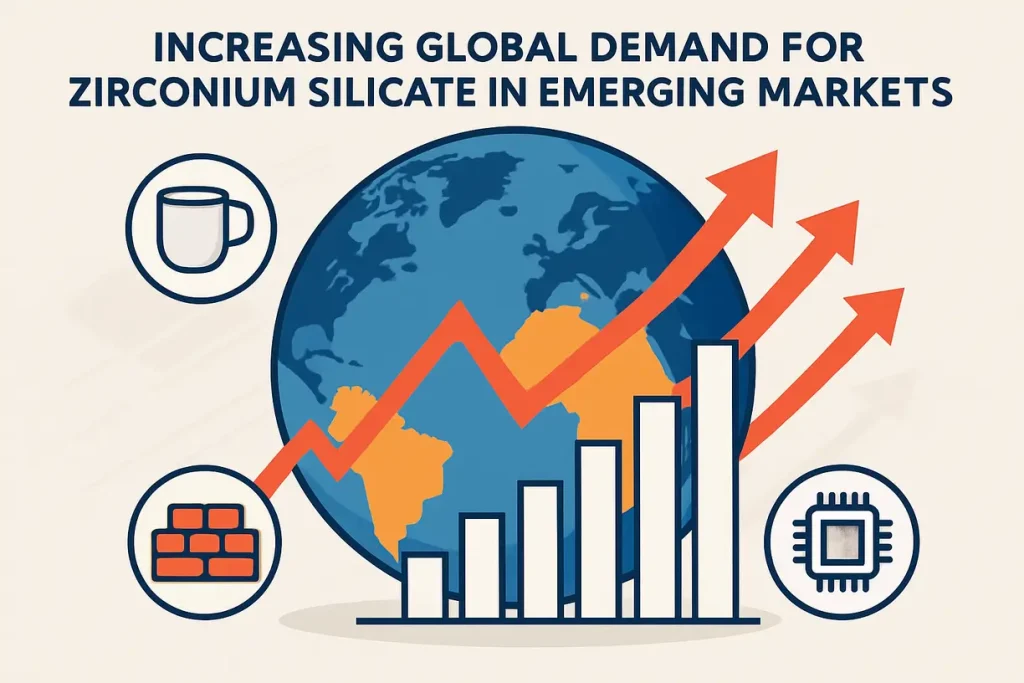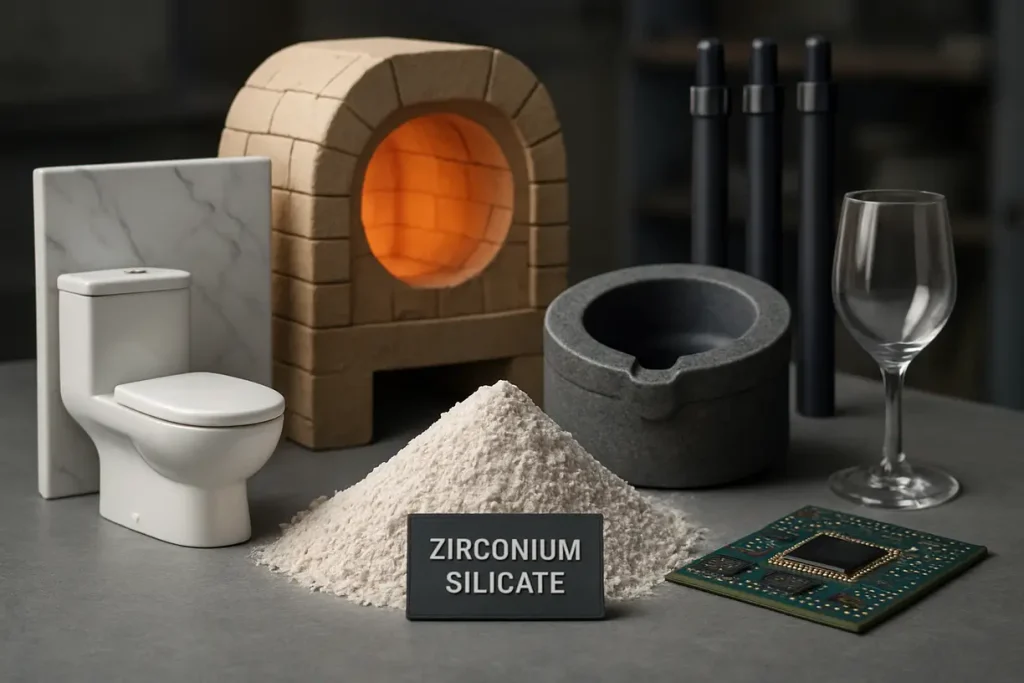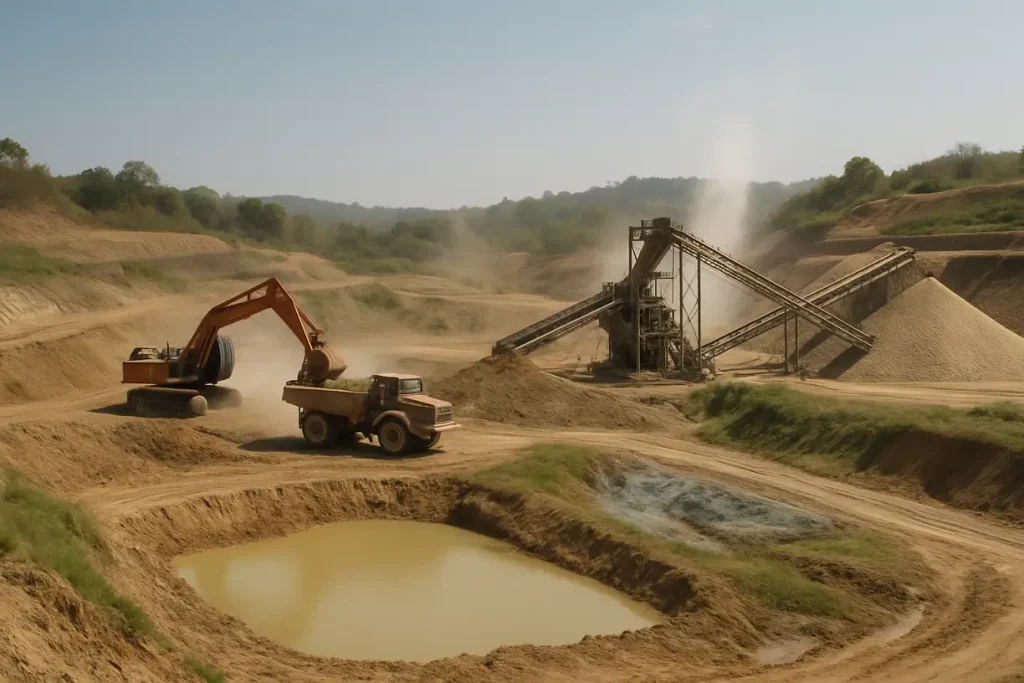As industries expand globally, understanding the dynamics of zirconium silicate demand in emerging markets is becoming increasingly important. Purchasing managers and decision-makers face challenges in identifying opportunities amidst this evolving landscape. This article provides practical insights into which markets are fueling zirconium silicate demand and outlines strategies to effectively tap into these opportunities. With data drawn from reliable industry sources and expert analyses, you will gain a comprehensive view of the market trends shaping future demand.

This image illustrates the growing global demand for zirconium silicate in emerging markets.
What Emerging Markets Are Influencing Zirconium Silicate?
Emerging markets refer to countries experiencing rapid economic growth and industrialization. These markets are critical because they often drive increased demand for various materials, including zirconium silicate. Key nations in this category include India, Brazil, and parts of Southeast Asia.
For instance, India’s expanding manufacturing sector is influencing its zirconium silicate consumption. The growth in ceramics, electronics, and other related industries is currently a strong growth driver.
Notably, the demand for zirconium silicate is not just limited to these nations. Other developing countries in Africa and South America are also beginning to recognize the benefits of this material in their industrial processes. These emerging markets represent a robust opportunity for suppliers seeking to expand their reach.
Key Emerging Markets
- India: Rapid growth in the ceramics and electronics sectors.
- Brazil: Significant expansion in ceramics manufacturing.
- Vietnam: Fast-tracking industrialization in construction and electronics.
- Nigeria: Emerging demand due to rising manufacturing activities.
- Indonesia: Growing ceramics and glass production.
To illustrate, here’s a table summarizing key emerging markets in terms of their zirconium silicate demand:
| Country | Market Potential | Key Industries |
|---|---|---|
| India | High growth in ceramics, electronics | Ceramics, Electronics |
| Brazil | Significant growth in ceramics manufacturing | Ceramics |
| Vietnam | Fast-tracking industrialization | Construction, Electronics |
| Nigeria | Emerging demand in manufacturing | Manufacturing, Construction |
| Indonesia | Growing ceramics and glass sectors | Ceramics, Glass |
How Do Economic Factors Affect Zirconium Demand?
Economic factors play a significant role in influencing zirconium silicate demand. This correlation is evident when examining GDP growth rates across various emerging markets. Rapid industrialization often leads to increased demand for raw materials, including zirconium silicate, as businesses expand their production capacities.
For example, countries like India and Vietnam are witnessing robust economic growth, which correlates with rising consumption of zirconium silicate. As these economies develop, there’s a greater focus on heavy industries, construction, and manufacturing— all crucial sectors that require zirconium silicate.
Economic Indicators Affecting Demand
- GDP Growth Rate: Higher growth typically correlates with increased demand.
- Investment Levels: More investments in industry lead to greater raw material needs.
- Stability: Economically stable countries see fewer fluctuations in demand.
- Industrialization Pace: Rapid industrial growth directly increases material consumption.
Here is a table showing the impact of GDP growth on zirconium silicate demand:
| Country | GDP Growth Rate (%) | Zirconium Silicate Demand |
|---|---|---|
| India | 7.5 | Increasing |
| Brazil | 3.5 | Steady |
| Vietnam | 6.0 | Increasing |
| Nigeria | 2.0 | Moderate |
| Indonesia | 5.5 | Increasing |
In summary, understanding these economic factors can help businesses anticipate market shifts and adjust their strategies accordingly.
Which Industries Are Key Consumers of Zirconium Silicate?
Several industries are major consumers of zirconium silicate. Recognizing these sectors is crucial for businesses hoping to tap into the growing demand.
Ceramics manufacturing is one of the largest consumers. Zirconium silicate is used to enhance the durability and aesthetics of ceramic products. In essence, the material helps improve quality while meeting customer demands for high-performance ceramics.
Electronics is another pivotal industry. Zirconium compounds are used in semiconductor applications, where they ensure reliability and efficiency. As technology continues to advance, the demand from this sector is expected to grow significantly.
Additionally, the foundry industry relies heavily on zirconium silicate for making molds and casting materials. The strength of zirconium silicate aids in producing durable molds needed for high-quality metal casting processes.

This image depicts various industries utilizing zirconium silicate, showcasing its broad applications.
Key Applications of Zirconium Silicate
- Ceramics: Enhances durability and aesthetics.
- Electronics: Important for semiconductor reliability.
- Foundry: Used for creating molds and castings.
- Glass Manufacturing: Improves product quality.
- Aerospace and Defense: Specialized applications in high-performance environments.
The table below details these industries and their respective zirconium silicate usage:
| Industry | Zirconium Silicate Usage | Growth Potential |
|---|---|---|
| Ceramics | Enhances durability and aesthetics | High demand |
| Electronics | Used in semiconductor manufacturing | Increasing demand |
| Foundries | Provides strength for molds and castings | Steady demand |
| Glass Manufacturing | Improves product quality | Moderate growth |
| Defense & Aerospace | Used in specialized applications | Niche but growing |
What Regional Trends Are Noteworthy in Zirconium Silicate Demand?
Different regions exhibit varying trends in the demand for zirconium silicate. Identifying these can provide businesses with the insights needed for strategic planning.
In the Asia-Pacific region, there is a pronounced demand surge due to rapid industrialization. Countries like India and Vietnam are investing heavily in manufacturing, thus increasing their zirconium silicate consumption.
In Africa, nations like Nigeria and South Africa are beginning to utilize zirconium silicate in emerging industries. The expansion of construction and manufacturing sectors signifies a move towards greater use of this essential material.
Europe is also adapting as demand shifts. As environmentally friendly practices become prevalent, industries within Europe are finding innovative ways to integrate zirconium-based products while adhering to regulatory standards.
Regional Demand Influencers
- Government Policies: Regulations can either promote or inhibit industry growth.
- Cultural Trends: Consumer preferences may affect demand in specific areas.
- Infrastructure Development: Ongoing projects increase material needs.
- Investment in Technology: Innovations drive the demand for advanced materials.
The following table highlights regional trends and their impact on demand:
| Region | Trend | Drivers |
|---|---|---|
| Asia-Pacific | Rapid industrialization | Increased manufacturing |
| Africa | Growing manufacturing sector | Economic development |
| Europe | Shift towards environmentally friendly practices | Regulatory compliance |
| North America | Steady technological advancements | Continued innovation |
How Does Global Trade Policy Impact Zirconium Supply?
Global trade policies can significantly impact the availability and pricing of zirconium silicate. Trade agreements, tariffs, and restrictions shape how materials are sourced and sold across borders.
For instance, tariffs can increase costs for businesses importing zirconium silicate. This may lead manufacturers to look for alternative suppliers or even adjust their production processes. On the other hand, favorable trade agreements can facilitate smoother transactions, enabling access to essential materials at competitive prices.
In the case of countries heavily reliant on imports of zirconium silicate, policy changes must be closely monitored. Retailers and purchasing managers need to stay informed about shifts in trade regulations as these decisions could influence their operational costs.
Factors Influencing Trade Policies
- Bilaterals and Multilaterals: Agreements can enhance or restrict trade flows.
- Tariff Changes: Adjustments can lead to immediate market impacts.
- Export Restrictions: Limitations can affect global supply dynamics.
- Political Stability: Countries with stable governments generally have more favorable trade policies.
Here’s a table that summarizes the relationship between trade policy and zirconium supply:
| Policy Change | Impact | Resulting Action |
|---|---|---|
| Increase in tariffs | Higher costs for importers | Sourcing alternatives |
| Favorable trade agreements | Lower costs, improved access | Enhanced imports from partner countries |
| Export bans | Limited supply for importing countries | Adjusting local supply chains |
What Role Does Innovation Play in Zirconium Silicate Markets?
Innovation is key to advancing the zirconium silicate market. As industries evolve, so do the applications for this material. Businesses that leverage innovative practices can improve efficiency and develop new products.
One area of innovation includes improved processing techniques. Enhanced methods in extraction and refinement can increase the quality of zirconium silicate, making it more appealing to manufacturers.
Additionally, the development of new applications is transforming the market landscape. For example, there’s an emerging use of zirconium silicate in the medical field, particularly in dental ceramics, due to its biocompatibility and aesthetic properties.
Innovations Driving the Market
- Advanced Processing Methods: Improve yield and reduce environmental impact.
- New Product Development: Innovative applications in sectors like healthcare.
- Sustainable Practices: Efforts towards eco-friendly extraction and production.
- Composite Materials: Zirconium silicate in combination with other materials for enhanced properties.
This table provides a quick overview of innovations shaping the zirconium silicate market:
| Type of Innovation | Description | Market Impact |
|---|---|---|
| Improved Processing Techniques | More efficient extraction and refinement | Higher quality products |
| New Applications | Introduction in sectors like medical and aerospace | Expanded market opportunities |
| Sustainability Initiatives | Focus on environmentally friendly practices | Enhanced corporate responsibility |
How Do Environmental Regulations Affect Zirconium Demand?
Environmental regulations are becoming increasingly pertinent in shaping zirconium silicate demand. Companies are under pressure to adopt sustainable mining and processing practices to meet standards set by governments and environmental organizations.
Regulations often dictate how materials are sourced and transported. Compliance with these laws can lead to increased operational costs. However, companies that embrace sustainability not only mitigate risks but can also enjoy a competitive advantage in the market.
For instance, firms that invest in eco-friendly mining techniques often see positive market responses, leading to long-term benefits. Consumers are increasingly aware of environmental impacts, thus aligning business practices with sustainable principles is crucial.
Examples of Environmental Regulations
- Mining Practices: Standards for reducing the ecological footprint.
- Emission Control: Regulations governing air and water pollution.
- Waste Management: Requirements for disposing of byproducts properly.
- Eco-labeling: Certification for environmentally friendly products.
Here’s a table summarizing the impact of environmental regulations:
| Regulation Type | Impact | Sector Response |
|---|---|---|
| Mining Regulations | Stricter sourcing practices | Investment in sustainable practices |
| Emissions Standards | Limits on processing emissions | Adoption of cleaner technologies |
| Waste Management Protocols | Requirements for disposal of byproducts | Implementation of recycling initiatives |

This image shows the environmental considerations of zirconium mining and processing.
What Are the Future Projections for Zirconium Silicate Demand?
Looking ahead, projections for zirconium silicate demand are optimistic. With growing industries and increasing awareness of the material’s benefits, it is anticipated that demand will rise in the coming decade.
For example, as the global ceramics market expands, particularly in Asia and Africa, the need for high-quality zirconium silicate will likely increase. Additionally, innovations in technology and new applications will further drive this demand.
However, potential challenges exist. Supply chain disruptions and fluctuations in market pricing can affect how industries utilize zirconium silicate. Businesses must remain prepared to adapt to ever-changing market conditions.
Factors Influencing Future Demand
- Technological Advancements: New production techniques and applications.
- Population Growth: Increased demand for construction and consumer goods.
- Global Economic Conditions: Economic health influencing manufacturing output.
- Regulatory Trends: Potential new environmental compliance requirements.
The table below showcases projected demand growth across various sectors:
| Sector | Projected Growth Rate (%) | Key Drivers |
|---|---|---|
| Ceramics | 5.0 | Increased demand in construction |
| Electronics | 6.5 | Expansion in tech innovations |
| Glass Manufacturing | 4.0 | Boost in consumer goods production |
| Dental Ceramics | 7.0 | Rise in cosmetic dentistry |
How Can Businesses Capitalize on Emerging Market Opportunities?
Businesses looking to enter emerging markets should formulate robust entry strategies. Partnering with local firms can provide valuable insights and pave the way for successful operations.
For example, local partnerships allow companies to navigate regulatory requirements more effectively. These alliances can help mitigate risks associated with new market entry, including cultural misunderstandings and supply chain complications.
Additionally, investing in market research is crucial. Understanding local preferences and demands can inform product development, ensuring that offerings align with consumer needs.
Strategies for Successful Market Entry
- Local Partnerships: Collaborate with established businesses for market penetration.
- Tailored Marketing: Develop strategies to appeal to local audiences.
- Regulatory Awareness: Stay informed about compliance requirements.
- Market Research: Conduct studies to understand local demand and trends.
Here’s a table outlining strategies for capitalizing on market opportunities:
| Strategy | Description | Expected Outcome |
|---|---|---|
| Form Local Partnerships | Collaborate with local businesses | Improved market entry success |
| Conduct Market Research | Analyze consumer behaviors and preferences | Tailored products and marketing messages |
| Adapt to Regulatory Changes | Stay updated on local laws and regulations | Reduced compliance risks |
What Are the Key Challenges in Sourcing Zirconium Silicate?
Sourcing zirconium silicate presents various challenges. One common issue is price volatility, which can significantly affect budgeting and financial forecasting.
Supply chain vulnerabilities also pose risks. Disruptions related to geopolitical tensions, trade restrictions, or natural disasters can hinder access to zirconium silicate.
Quality control is another concern. Ensuring that the material meets standards is essential for maintaining product integrity. Businesses must be vigilant in assessing the quality of their supply sources.
Challenges in Sourcing Raw Materials
- Vendor Reliability: Dependable suppliers are crucial for steady supply.
- Price Fluctuations: Market volatility can disrupt cost estimations.
- Quality Assurance: Consistent standards must be upheld.
- Logistical Issues: Transportation can complicate supply chains.
Here’s a summary of the main challenges in sourcing zirconium silicate:
| Challenge | Impact | Mitigation Strategy |
|---|---|---|
| Price Volatility | Affects budgeting and forecasts | Diversify suppliers |
| Supply Chain Vulnerabilities | Disruptions can halt production | Develop contingency plans |
| Quality Control | Inconsistent material can compromise products | Implement rigorous quality assessments |
Conclusion
This article provides valuable insights into emerging markets driving zirconium silicate demand, highlighting the influence of economic factors, key industries, and innovative applications. Understanding these insights can significantly benefit businesses by informing strategic decisions and optimizing operations. With the rapid growth in essential sectors such as ceramics and electronics, companies must remain agile and responsive to market changes.
Moreover, as sustainability becomes a priority, businesses that adopt environmentally friendly practices will not only meet regulatory demands but also enhance their reputation and appeal to conscientious consumers. By leveraging local partnerships and conducting thorough market research, organizations can better navigate the complexities of emerging markets and capitalize on opportunities for growth.
With a stronger grasp of these dynamics, companies like Global Industry can position themselves effectively to capture new market opportunities. To further enhance your strategy and stay ahead of the competition, reach out today and gain access to tailored resources that will assist you in successfully navigating these emerging markets. Embracing change and innovation will be key to thriving in the evolving landscape of zirconium silicate demand.
FAQ
Q1: Which countries are considered emerging markets for zirconium silicate?
Countries such as India, Brazil, and Vietnam are rapidly expanding their demand due to industrial growth. These nations have robust manufacturing sectors and are investing heavily in infrastructure, which leads to increased consumption of materials like zirconium silicate. Additionally, regions in Africa and parts of South America are also beginning to emerge as significant players in the zirconium market as their economies develop.
Q2: What industries primarily use zirconium silicate?
Key industries that utilize zirconium silicate include ceramics, electronics, and foundry manufacturing. In ceramics, it enhances the durability and aesthetic qualities of products. The electronics sector employs zirconium for semiconductor applications, ensuring performance reliability. Furthermore, the foundry industry uses zirconium silicate for mold-making and casting, which is essential for producing high-quality metal parts.
Q3: How do trade policies affect zirconium supply?
Trade policies play a crucial role in determining the availability and pricing of zirconium silicate. Tariffs on imports can raise costs for manufacturers, leading them to seek alternative suppliers. Conversely, favorable trade agreements may lower import barriers, facilitating smoother transactions. Consequently, businesses must stay informed about evolving trade regulations, which can directly impact their supply chain strategy.
Q4: What are the environmental impacts of zirconium mining?
Zirconium mining can have significant ecological footprints, including habitat disruption, water pollution, and resource depletion. As a result, adherence to environmental regulations is critical for sustainable practices. Companies are increasingly being held accountable for their environmental impact, and many are adopting more eco-friendly mining and processing methods to mitigate adverse effects on local ecosystems.
Q5: How can businesses effectively enter emerging markets?
Companies aiming to enter emerging markets should focus on forming local partnerships, as these alliances can provide valuable insights into market dynamics and regulatory requirements. Additionally, conducting thorough market research is essential for understanding local consumer preferences and demand trends. By adapting their strategies accordingly and being culturally sensitive, businesses can navigate challenges and enhance their chances of success in new markets.
